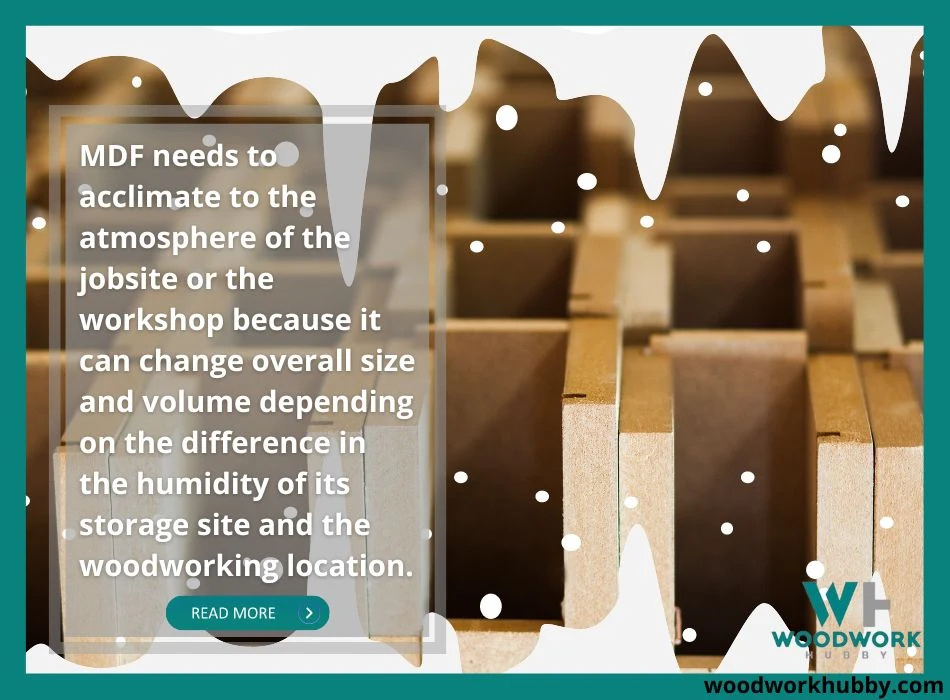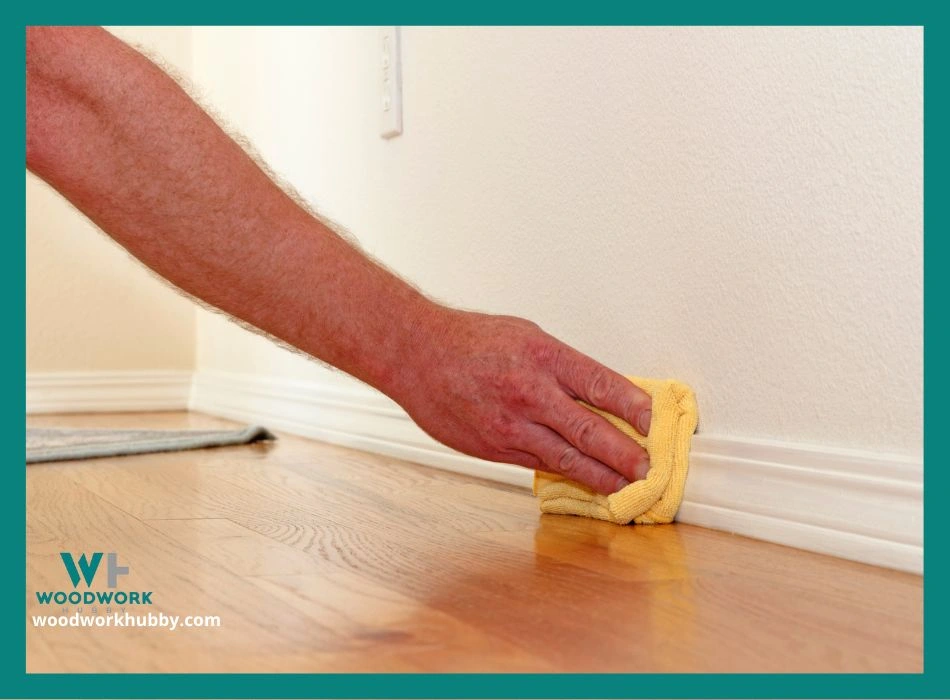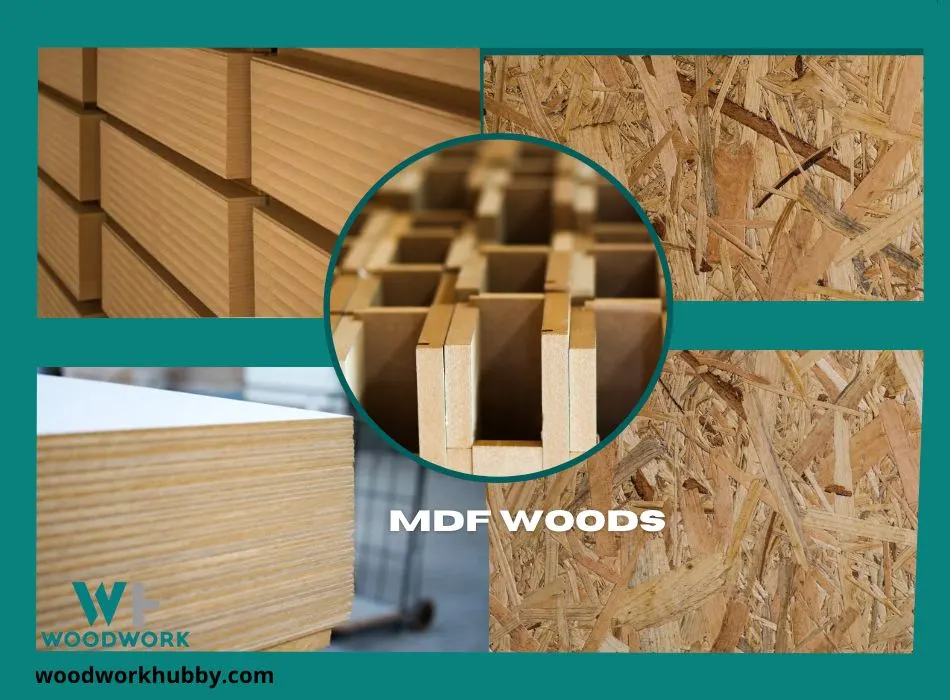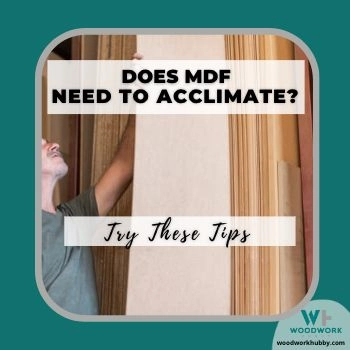I procrastinate after getting all the materials for my projects. And usually, this is productive because the materials, usually wood, need to acclimate to the atmosphere of the location where it is used. My current project is an MDF baseboard, and I am having a hard time justifying the delay because MDF doesn’t need to acclimate as much. Still, you cannot start using MDF as soon as you get it.
MDF needs to acclimate to the atmosphere of the jobsite or the workshop because it can change overall size and volume depending on the difference in the humidity of its storage site and the woodworking location.

In this article, you will learn more about what dictates how crucial acclimating MDF is because not all projects require the same period of acclimation. You will also learn the extent to which MDF expands and contracts and how long different types of MDF must acclimate before use. But first, let’s go over some tips.
| MDF Type | Minimum Acclimation Period | Tip |
|---|---|---|
| Ultra Light MDF | 1.5 days | Space out individual sheets for maximum breathing. |
| Light MDF | One day | Flip the boards after 24 hours to improve breathing |
| Heavy MDF | 12 hours to 1 day | Make the boards stand against their height to acclimate the whole structure. |
Does MDF Have To Acclimate?
MDF has to acclimate for at least 24 hours so the overall project doesn’t warp when the wood board reacts to the environment. Acclimating MDF overnight can help make individual sheets more predictable in stability and structure.
See my article does MDF warp when painted? This can have an effect on if you have let it acclimate.
How important acclimating is for MDF depends on a few factors, like the project height, breathing room, and the environment.
The environment – The most critical factor that governs the need for acclimating any type of wood is the job site’s atmosphere. If it is just as humid or dry as the storage site of the MDF, there is no need to acclimate the boards. Just having the boards at the prior storage site has already acclimated them.
This applies in a very narrow context, though. If you get MDF from Home Depot and the Home Depot’s storage atmosphere is just as humid as your workshop, then no acclimation is required. But if you get your lumber from across state lines and have it lugged to your shop after a multi-day trip, the truck in which the MDF spent a few days is the atmosphere it is acclimated to.
In that case, you will need to reacclimate the MDF even if your shop’s atmosphere is the same as the lumberyard’s environment.
As you can see, it is very difficult to confirm that acclimation isn’t needed. So it is better to err on the side of caution and acclimate MDF for 24 hours anyway.
The lighter the MDF, the higher the need to acclimate it. And this has to do with the degree of potential shrinkage and expansion, which occurs more readily in light and ultra-light MDF compared to thick and stiff MDF.
The breathing room – Acclimating MDF becomes increasingly important for projects that have less breathing room. The extent to which wood (or MDF) can shrink or expand without compromising the structure is its breathing room. Understandably, projects with less breathing room need material that has already been breathing in the environment for a few days. This ensures that the material will not change its size once it is used in the project.
The project height – The final factor that affects MDF’s need for acclimating is the height of the project. The projects that are not too tall, like flooring, do not have as serious an acclimating need as tall structures. That’s because warping has a snowball effect on function.
A warped floorboard can make an irregular surface to step on, but a warped construction beam can be downright dysfunctional. MDF is never used in heavy-load use cases, so these boards’ acclimation requirements aren’t as extensive as those of wood.
With all these factors covered, we arrive at the conclusion that MDF needs to be acclimated for the longest period if it comes from a drastically different environment and the least when it comes from a relatively similar atmosphere and the project it is being used for has a decent breathing room.
Breathing room is inherent in some projects and is deliberately left in others depending on how much a material breathes. Knowing whether MDF shrinks and expands can help you decide if you need to leave breathing room in your project.
If you want to know if Primed Wood Need To Acclimate, please refer to the link to learn more.
Does MDF Shrink And Expand?
MDF does shrink and expand but less than wood. On average, MDF shrinkage is half of its equivalent wood. Where wood shrinks 0.50 inches (12mm), MDF shrinks 0.25 inches (6mm).
The shrinkage or expansion of MDF is hindered by the adhesive content of the board. Since there is less wood matter in MDF, the overall change in size isn’t that obvious. But even with a 50% lower size change, the material can warp if constructed too tightly.
You don’t have to intentionally construct breathing room into MDF projects if you acclimate the wood board properly. That said, if it is possible to leave some room in specific applications, like flooring and baseboards, it doesn’t hurt to have some room for movement.
Do You Have To Let The Baseboards Acclimate?
You have to let baseboards acclimate for one to three days. MDF baseboards breathe half as much as wood. Since wood baseboards need three days of acclimation at a minimum, MDF baseboards need one and a half days of acclimation.
Leaving 3/8″ (9.5mm) room for movement on the edges, further minimizing the risk of warping. Aside from the potential of warping, you should also be concerned about the durability of the material.
Is The MDF Baseboard Durable?
MDF baseboard is not as durable as wood baseboards but requires less acclimation and is more predictable. It is also fault-free and as smooth as the base can get.

Since baseboards don’t bear a heavy load, they don’t have to be as durable as wall and flooring materials. Moreover, the low use height alongside minimal direct impact makes baseboards the perfect use case for MDF.
Does MDF Expand And Contract?

MDF expands and contracts half as much as wood, but unlike wood, it doesn’t return to its original shape as easily if it bends or warps when breathing.
Dimensionally stable wood types can expand and contract without warping. But if MDF is not acclimated properly and begins to expand in a tightly constructed project, its individual particles will go out of order and never return to their previous position.
| My Recommended MDF Woods | Where To Buy? |
|---|---|
| 1/4 In MDF Wood Chipboard Sheets for Crafts, Engraving, Painting | AMAZON |
| 4 Pack Veneered MDF Double Sided Paulownia Wood ,MDF Core ,6.4mm 1/4th Inch, 10″x16″ | AMAZON |
Final Thought
MDF needs to acclimate the most when it is light and the least when it is used in a breathable project and is heavy. In either case, it is a good idea to store MDF at the worksite for at least 24 hours and then leave 3/8″ breathing room if the project specs allow it.
-
Does MDF Need To Acclimate? Try These Tips

I procrastinate after getting all the materials for my projects. And usually, this is productive because the materials, usually wood, need to acclimate to the atmosphere of the location where it is used. My current project is an MDF baseboard, and I am having a hard time justifying the delay because MDF doesn’t need to…




